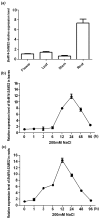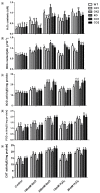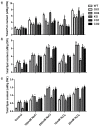Overexpression of S-Adenosyl-l-Methionine Synthetase 2 from Sugar Beet M14 Increased Arabidopsis Tolerance to Salt and Oxidative Stress
- PMID: 28420190
- PMCID: PMC5412431
- DOI: 10.3390/ijms18040847
Overexpression of S-Adenosyl-l-Methionine Synthetase 2 from Sugar Beet M14 Increased Arabidopsis Tolerance to Salt and Oxidative Stress
Abstract
The sugar beet monosomic addition line M14 is a unique germplasm that contains genetic materials from Beta vulgaris L. and Beta corolliflora Zoss, and shows tolerance to salt stress. Our study focuses on exploring the molecular mechanism of the salt tolerance of the sugar beet M14. In order to identify differentially expressed genes in M14 under salt stress, a subtractive cDNA library was generated by suppression subtractive hybridization (SSH). A total of 36 unique sequences were identified in the library and their putative functions were analyzed. One of the genes, S-adenosylmethionine synthetase (SAMS), is the key enzyme involved in the biosynthesis of S-adenosylmethionine (SAM), a precursor of polyamines. To determine the potential role of SAMS in salt tolerance, we isolated BvM14-SAMS2 from the salt-tolerant sugar beet M14. The expression of BvM14-SAMS2 in leaves and roots was greatly induced by salt stress. Overexpression of BvM14-SAMS2 in Arabidopsis resulted in enhanced salt and H₂O₂ tolerance. Furthermore, we obtained a knock-down T-DNA insertion mutant of AtSAMS3, which shares the highest homology with BvM14-SAMS2. Interestingly, the mutant atsam3 showed sensitivity to salt and H₂O₂ stress. We also found that the antioxidant system and polyamine metabolism play an important role in salt and H₂O₂ tolerance in the BvM14-SAMS2-overexpressed plants. To our knowledge, the function of the sugar beet SAMS has not been reported before. Our results have provided new insights into SAMS functions in sugar beet.
Keywords: ">l-methionine synthetase; S-adenosyl-; antioxidant system; polyamine; salt stress; sugar beet M14.
Conflict of interest statement
The authors declare no conflict of interest.
Figures







Similar articles
-
Overexpression of a S-Adenosylmethionine Decarboxylase from Sugar Beet M14 Increased Araidopsis Salt Tolerance.Int J Mol Sci. 2019 Apr 23;20(8):1990. doi: 10.3390/ijms20081990. Int J Mol Sci. 2019. PMID: 31018555 Free PMC article.
-
Quantitative proteomics and phosphoproteomics of sugar beet monosomic addition line M14 in response to salt stress.J Proteomics. 2016 Jun 30;143:286-297. doi: 10.1016/j.jprot.2016.04.011. Epub 2016 May 24. J Proteomics. 2016. PMID: 27233743
-
Identification of a sugar beet BvM14-MADS box gene through differential gene expression analysis of monosomic addition line M14.J Plant Physiol. 2011 Nov 1;168(16):1980-6. doi: 10.1016/j.jplph.2011.05.027. Epub 2011 Jul 31. J Plant Physiol. 2011. PMID: 21807438
-
Salt stress response of membrane proteome of sugar beet monosomic addition line M14.J Proteomics. 2015 Sep 8;127(Pt A):18-33. doi: 10.1016/j.jprot.2015.03.025. Epub 2015 Apr 3. J Proteomics. 2015. PMID: 25845583 Review.
-
OMICS Technologies and Applications in Sugar Beet.Front Plant Sci. 2016 Jun 22;7:900. doi: 10.3389/fpls.2016.00900. eCollection 2016. Front Plant Sci. 2016. PMID: 27446130 Free PMC article. Review.
Cited by
-
Mechanisms of salinity tolerance and their possible application in the breeding of vegetables.BMC Plant Biol. 2023 Mar 14;23(1):139. doi: 10.1186/s12870-023-04152-8. BMC Plant Biol. 2023. PMID: 36915096 Free PMC article. Review.
-
Insights from a Multi-Omics Integration (MOI) Study in Oil Palm (Elaeis guineensis Jacq.) Response to Abiotic Stresses: Part Two-Drought.Plants (Basel). 2022 Oct 20;11(20):2786. doi: 10.3390/plants11202786. Plants (Basel). 2022. PMID: 36297811 Free PMC article.
-
Multi-omics data integration reveals link between epigenetic modifications and gene expression in sugar beet (Beta vulgaris subsp. vulgaris) in response to cold.BMC Genomics. 2022 Feb 17;23(1):144. doi: 10.1186/s12864-022-08312-2. BMC Genomics. 2022. PMID: 35176993 Free PMC article.
-
Metabolism and Regulatory Functions of O-Acetylserine, S-Adenosylmethionine, Homocysteine, and Serine in Plant Development and Environmental Responses.Front Plant Sci. 2021 May 7;12:643403. doi: 10.3389/fpls.2021.643403. eCollection 2021. Front Plant Sci. 2021. PMID: 34025692 Free PMC article. Review.
-
Effects of Simulated Space Radiations on the Tomato Root Proteome.Front Plant Sci. 2019 Oct 24;10:1334. doi: 10.3389/fpls.2019.01334. eCollection 2019. Front Plant Sci. 2019. PMID: 31708949 Free PMC article.
References
-
- Turan M.A., Elkarim A.H.A., Taban N., Taban S. Effect of salt stress on growth, stomatal resistance, proline and chlorophyll concentrations on maize plant. Afr. J. Agric. Res. 2009;4:893–897.
-
- Barkla B.J., Castellanos-Cervantes T., de León J.L., Matros A., Mock H.P., Perez-Alfocea F., Salekdeh G.H., Witzel K., Zörb C. Elucidation of salt stress defense and tolerance mechanisms of crop plants using proteomics—Current achievements and perspectives. Proteomics. 2013;13:1885–1900. doi: 10.1002/pmic.201200399. - DOI - PubMed
MeSH terms
Substances
LinkOut - more resources
Full Text Sources
Other Literature Sources
Molecular Biology Databases

